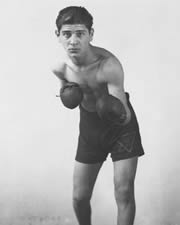
Sammy Luftspring was a Jewish Canadian boxer. A former Canadian Welterweight Champion and highly ranked in the Welterweight class during his career, Luftspring was forced to retire from the sport due to an eye injury. He was inducted into Canada’s Sports Hall of Fame in 1985.
Luftspring was born and raised in a low class residential area of Toronto. It was home to many Eastern European (primarily Jewish) and Italian immigrants. He began his boxing career in 1932 out of Brunswick Talmud Torah, a local Toronto Jewish community and recreational centre. Throughout his career, he wore a Magen David on his trunks. Over the next four years, he fought 105 times (attaining a record of 100-5) and captured Golden Gloves Tournaments in various weight classes ranging from bantamweight to welterweight.
By 1933, he was the Ontario amateur lightweight champion and regarded as one of the best amateur boxing talents.
In 1933, Luftspring was involved in the infamous Toronto Christie Pits Riots. A riot occurred at Christie Pits Park following tensions that occurred during a series of amateur softball games. Fighting broke out between a group of young Jewish and Italian men and the local Swastika Club, a group of Canadian Nazi sympathizers.


